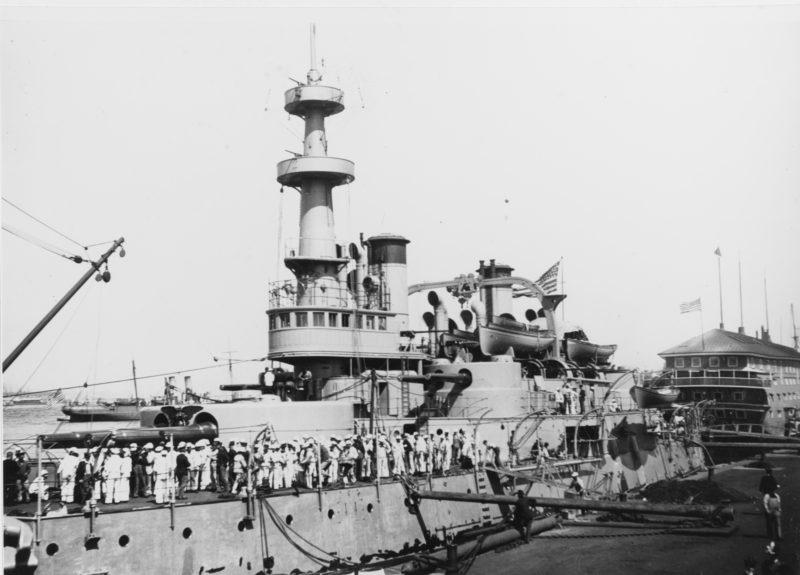Florida’s Underwater Archaeological Preserves form a heritage diving trail, made up of 12 historically significant shipwrecks from different time periods. San Pedro wrecked in 1733; SS Copenhagen wrecked in 1900; and Vamar wrecked in 1942, for example. A member of the public nominates potential preserves, which must be easily accessible, host a variety of sea life, and have recognizable and interesting features. After they become preserves, a variety brochures, underwater plaques, and the website help explain the wreck’s history. Preserves are popular with both skin- and scuba divers.
History of the USS Massachusetts
USS Massachusetts sheds light on a lesser-known aspect of Florida’s history: The Spanish-American War. The USS Massachusetts was one of the three most powerful heavy-caliber and armored Indiana class vessels of the time, and part of the newly formed United States “Steel Navy.” It was a pre-dreadnaught type battleship, which were built between 1880 and 1905. These ships were built after older and outdated ironclads, but before heavier battleships featuring long-range guns.
William Cramp and Sons of Philadelphia built the USS Massachusetts in 1891. It was 350 feet long (107 m) with a 69-foot (21 m) beam and a draft of 24 feet (7 m). The battleship had almost 10,000 horsepower, allowing it to reach a 15-knot cruising speed. Heavily armed, the Massachusetts carried two 13-inch guns forward and aft and four 8-inch secondary batteries, mounted amidships. The ship also contained four torpedo tubes and a variety of small arms.
Launched in 1893, the ship saw battle during the Spanish-American War in 1898, serving as part of the blockade of Cuba. On May 31 near the port of Santiago, USS Massachusetts, along with battleships Iowa and New Orleans, exchanged fire with Cristóbal Colón, forcing the Spanish cruiser to retire into the inner harbor. USS Massachusetts also ran Reina Mercedes aground before traveling to Puerto Rico in support of the occupation.
After the war
After the Spanish-American War, the battleship continued to serve with the North Atlantic Squadron. In 1903, off Culebra, Puerto Rico, target practice resulted in a premature detonation of one of the 8-inch turrets, causing the death of nine sailors. In 1910, the Massachusetts became a training ship for midshipmen. The Navy decommissioned the ship in 1914.
During World War I in 1917, it was recommissioned for naval gunnery crew training before its final decommission in 1919. The War Department scuttled the ship in 1921 off the coast of Pensacola to be used as a target ship for artillery fire. The wreck has been bombarded with railguns and experimental artillery, and divers attempting to remove lead ballast from the gun turrets reportedly dynamited the wreck in the 1950s. The explosions collapsed the upper decks, causing the turrets to tilt inward and dislodge the four 8-inch gun turrets from their mountings.
In 1956, various companies attempted to salvage USS Massachusetts, but Pensacola’s fishing community moved to stop the work; the battleship had become a popular fishing platform. The case against its salvage went all the way to the Supreme Court, and the site ultimately became the property of the State of Florida. In 1990, a Pensacola diver nominated it as the fourth Underwater Archaeological Preserve. The site was dedicated in 1993, on the centennial of its launching. It joined the National Register of Historic Places in 2001.
Diving the USS Massachusetts
Today, the marine-encrusted battleship rests quietly on the white sands of the Gulf of Mexico. It’s 1.5 miles south/southwest of Pensacola Pass. A bronze plaque designating the wreck as an Underwater Archaeological Preserve marks the spot. Due to the shallow depth (26 to 30 feet), the turrets rise close to the surface and at times are awash. Artillery fire and general deterioration have exposed various features, providing divers the opportunity to witness the battleship’s internal mechanisms. The patient diver may identify turrets, turret covers, ammunition tubes, cupolas, boiler-hatch covers, the anchor chain, and the fighting top.
After 96 years on the ocean bottom, the wreck is a refuge for Gulf marine life, acting as an artificial reef in Fort Pickens Aquatic Preserve. Divers can expect to see mollusks, crustaceans, various fish, sponges, soft corals, and turtles. Eileen Beard, owner of Scuba Shack in Pensacola, has been diving the wreck for years.
“When the conditions are right the wreck really is one of the most beautiful dives to make,” she says. “It has been down for so long that it has a complete ecosystem. Once we saw seven goliath groupers. The ecosystem never ceases to amaze me.”
When to dive the site
Beard stresses the importance of diving USS Massachusetts at the appropriate time: slack high tide. The nearby pass affects currents and visibility, and diving at an unsuitable time can cause low visibility and strong surge. Visitors should also use caution when navigating to the wreck, which comes right up to the surface. Interested divers can obtain a laminated map from local dive shops to help orient themselves on the shipwreck.
By guest author Melissa R. Price





